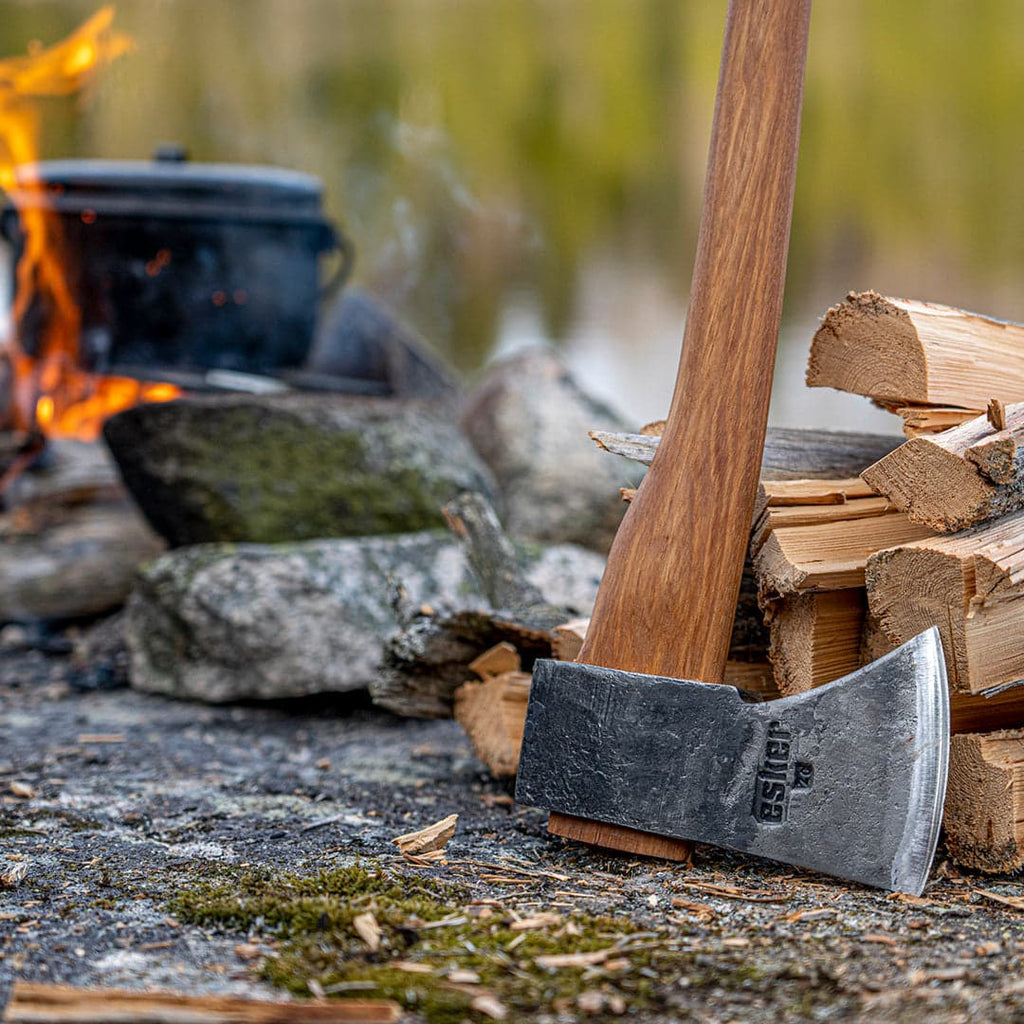The Ultimate Guide to Splitting Firewood with the Esker Splitting Axe

After a long canoe trip, nothing brings as much joy back home as kindling a fire in our sauna’s wood stove to sweat away the bugs and hard work. Our stove has a quirk—it can’t burn hard wood as it leaves too many coals for the heat we like. So, we harvest and bring home dry-standing Jackpine or Black Spruce, two of the hottest woods in the northern country. But, they sure are knotty and gnarled, presenting a real challenge for just any old axe. That’s where my Esker Splitting Axe steps in.
The Esker Splitting Axe: A Tool of Precision and Power
Leaning against the wood shed’s wall, my Esker Splitting Axe is always ready for action. The sheath guards the broad edge while showcasing the craftsmanship of the wedges forged into the axe’s face. The handle, straight and strong, is long enough for power but not so lengthy that it creates distance from the chopping block, or can’t be taken out into the field. It’s just the right length for packing with you and aiming, lifting, and striking with precision.
I pick up the first round of wood—a Jackpine with stubborn branches and warped grain. As I line up the axe head on the piece, I admire the texture of the blade, a testament to the blacksmith’s skill. This isn’t just a tool; it’s a piece of functional art. I lift the weighty head above my own, remembering that each swing isn’t just about splitting wood but engaging with a beautifully crafted instrument.
Understanding the Esker Splitting Axe: Properties and Function

Properties of Your Esker Splitting Axe
Your Esker Splitting Axe is designed for one purpose: splitting wood. Here’s what makes it ideal for the job:
- Wedge-Shaped Head: The broad, wedge-shaped head is what sets the Esker Splitting Axe apart. It’s designed to exert force effectively and split wood fibers apart rather than cutting through them. This makes it perfect for tackling tough, knotty wood.
- Handle Length: The handle of your Esker Splitting Axe strikes a balance between a hatchet’s compactness and a felling axe’s length. It’s long enough to give you the leverage needed for powerful swings while keeping you close enough to the chopping block for better control, and can be packed on the side of a canoe pack or on a freight toboggan for field use.
- Weight and Balance: Heavier than a hatchet but carefully balanced, the Esker Splitting Axe’s weight is concentrated towards the head. This helps drive the axe through the wood with minimal effort while remaining manageable and not too cumbersome.
- Edge Shape: The edge of your Esker Splitting Axe is sharp, but sports a wide, convexed edge - allowing it to split wood along its grain rather than cutting it. It’s ideal for dealing with tough, knotty wood without getting stuck.
How to Use Your Esker Splitting Axe

Using your Esker Splitting Axe effectively means understanding its design and applying proper technique:
- Positioning: Place the wood on a stable chopping block. Stand with your feet shoulder-width apart to maintain balance. Make sure there’s enough space around you to swing the axe safely. If no suitable block is available, split wood on your knees to avoid
- Grip: Grip your Esker Splitting Axe with both hands—one near the end of the handle and the other closer to the head. This grip allows for better control and maximizes the power of each swing.
- Swing Technique: Raise the axe above your head, using your entire body to generate speed. The hand nearer the head should slide down the handle as you swing. Swinging an axe is all about velocity - the grip helps maximize the efficiency of each swing, and aims the head of the axe. Be sure to loosen your grip on the handle when the head makes contact with the wood - letting the head do the work. Do not keep pushing into the swing once contact is made.
- Safety Precautions: Always be mindful of your surroundings. Wear protective gear such as safety glasses to shield yourself from flying wood chips and debris. Avoid distractions and maintain focus during each swing to prevent accidents.
General Care and Safety of Your Esker Splitting Axe
Taking care of your Esker Splitting Axe is essential for its performance and longevity. Here’s how to keep it in top shape:
- Sharpening: Regularly sharpen the axe head to keep it effective. Use a sharpening stone or file to maintain a clean, sharp edge. A sharp axe is not only safer but also more efficient.
- Cleaning: After each trip or use, clean your Esker Splitting Axe to remove sap, dirt, and debris. This helps prevent rust and keeps the axe in good working condition. Wipe the blade with a cloth or brush to ensure it stays clean
- Storage: Store your Esker Splitting Axe in a dry place, away from heat sources, and oil the head to prevent rust. Use the sheath to cover the blade and protect it from damage. Proper storage extends the life of the axe.
- Handle Maintenance: Check the handle regularly for cracks or splinters. Treat the handle with oil to prevent the wood from drying out and becoming brittle. A well-maintained handle ensures better control and safety.
- Safety Checks: Before each use, inspect your Esker Splitting Axe for any signs of damage. Make sure the head is securely attached to the handle. Regular safety checks help prevent accidents and ensure that the axe performs effectively.
The Joy of Splitting Wood

As I work through a small stack of rounds, each piece of wood presents its own unique challenge. The Jackpine with its twisted grain and knotty branches requires thoughtful strikes to find the best splitting point. The Esker Splitting Axe makes this task not just manageable but enjoyable. Its design handles even the most stubborn wood with ease, turning what could be a chore into a rewarding experience.
Splitting wood is more than just preparing firewood; it’s an engaging process that connects you with the natural world and the craftsmanship of your tool. The satisfaction of seeing a pile of split wood, ready to bring warmth to our sauna, makes every swing worthwhile. Each piece of wood tells its own story, and with the right axe, you get to be a part of it.
Conclusion:
As the sun sets and casts a warm glow over our little piece of paradise, the Esker Splitting Axe stands tall and proud. It’s more than just a tool—it’s a companion that turns the rugged task of splitting wood into a moment of artful engagement. Each swing connects you with the heart of the wood, revealing its hidden character and story.
There’s a certain magic in the way the axe’s broad head cleaves through the stubborn Jackpine and Black Spruce, transforming them into manageable pieces that will soon crackle in the sauna’s stove. It’s not merely about preparing for warmth; it’s about the satisfaction of mastering a craft and the joy of seeing your efforts rewarded with a blaze that dances with life.
So, the next time you reach for your Esker Splitting Axe, take a moment to savour the process. Feel the weight of the axe in your hands, appreciate the craftsmanship that went into its creation, and revel in the rhythm of each swing. In these simple, repetitive motions, there’s a deeper connection to nature and to the heritage of those who came before us. It’s a timeless dance between human, tool, and wood, creating warmth and comfort that speaks to the soul.
In the end, it’s not just about splitting wood; it’s about celebrating the artistry of the axe and the tranquility it brings to your fireside. Each piece of firewood, split with care and precision, is a testament to the beauty of the process and the warmth it will soon provide. With your Esker Splitting Axe, you’re not just preparing for the cold—you’re embracing the poetry of the craft and the comfort of a well-earned fire.
Happy Trails
- David Jackson


